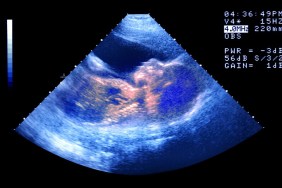While a breech presentation at full term pregnancy (37 weeks) is relatively rare (affecting at approximately 3 – 4 percent of pregnancies) it still touches hundered of thousands of women each year.
How I Learned My Baby Was in Breech
I was informed at my 36 week check-up that my baby was likely in the breech position, but this had to be confirmed, so I wen tto the hospital the following day and it was, in fact, confirmed that my baby was presenting in a bottom-down position. It was recommended I try an External Cephalic Version (ECV) to try and turn the baby manually.
What is an External Cephalic Version?
An ECV is not an invasive procedure; it involves a senior doctor or consultant using external manipulation of your belly in an attempt to try and turn the baby into a cephalic (head down) position. The hope is that you will then be able to deliver in a natural, uncomplicated way avoiding possibility of requiring a c-section. The success rate of the procedure is around 50% but varies depending on various factors, such as the size and position of the baby, amount of fluid present, and whether the mother has had a baby before. There is also a 5% chance that your baby could flip back to breech after being turned. When I asked whether it woul hurt, I was told that it would be “uncomfortable but not painful.”
After reading about the risks (there is a 0.5% chance that the baby will become distressed during the procedure requiring an emergency c-section) and success rates I decided to go ahead as I really wanted to have a natural birth if possible. I was given a more detailed scan which showed that there were good levels of fluid around my baby then I was booked in for my ECV on the following Monday at just under 37 weeks.
My Experience with External Cephalic Version
I had to fast for six hours before the procedure, and upon arrival I was hooked up to a monitor to trace the baby’s heartbeat for an hour and ensure there were no problems. I was also scanned again to make sure she was still breech (which she was). A uterus relaxing medication was injected which was painless (I didn’t even feel it), and half an hour later, the procedure began.
I won’t lie and say it didn’t hurt, because it did, but I knew they were monitoring my baby throughout and was reassured that it wasn’t hurting her, which was my top priority. The doctor managed to move my baby a small amount before she pushed her bottom down and head up into my ribs and refused to budge further. As soon as the doctor stopped, the discomfort quickly subsided. I asked if they could try again but unfortunately the same thing happened. They tried a third time, however, my little one was still being stubborn and reluctantly we had to admit defeat.
Although it didn’t work for me, I was glad to have tried the ECV and any pain I felt only lasted while the procedure was being done (which takes a just few minutes or until you ask them to stop if it hurts too much). I felt bruised the following day but my baby was moving well and seemed genuinely unfazed. If I have another breech baby I will certainly repeat the procedure as I felt it was worth trying.








